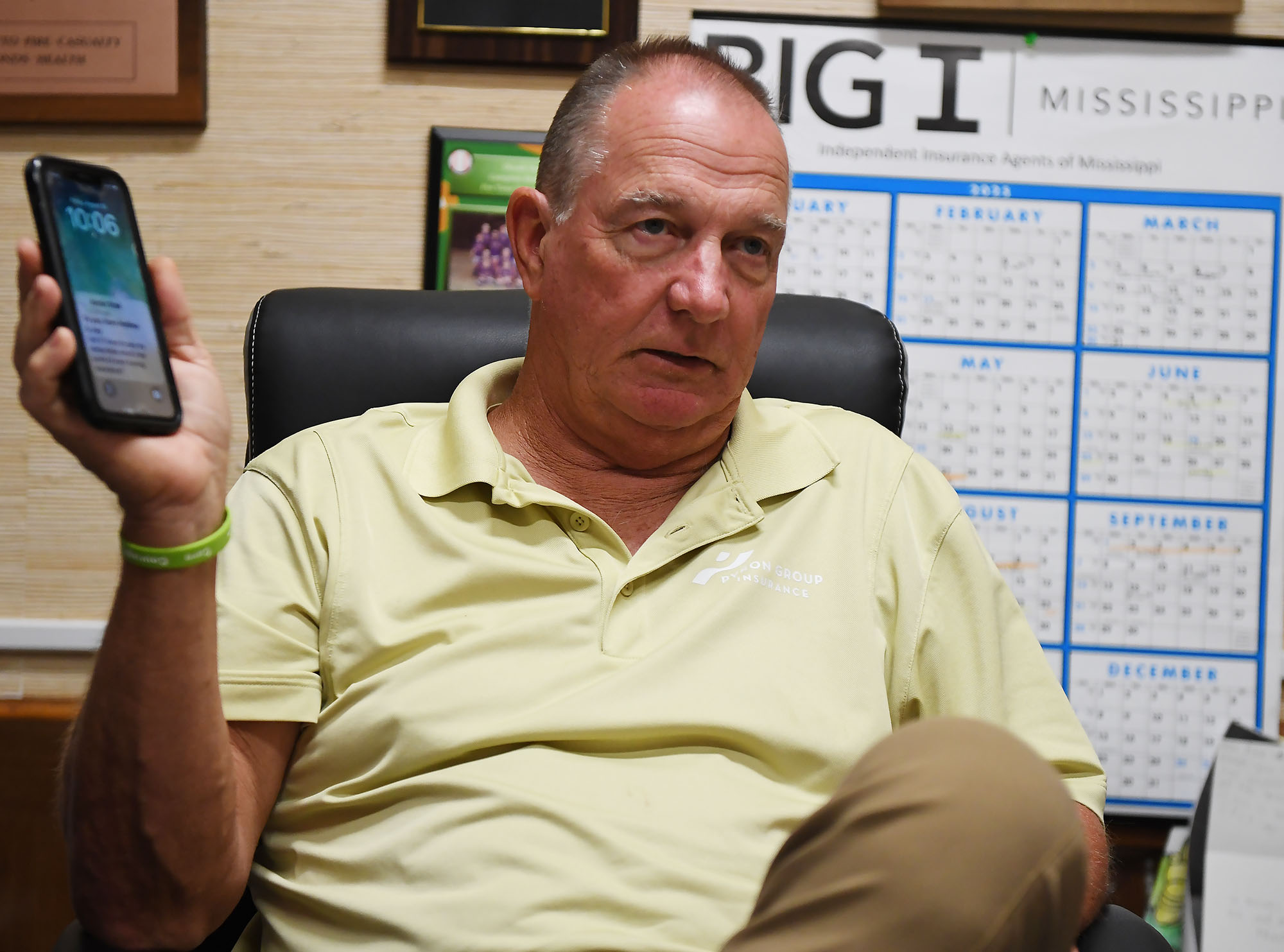Mississippi Today
Mississippi welfare scandal inspires national safety net improvements

The decision to use $1.3 million in Mississippi’s federal welfare dollars to fund a boot camp-style fitness program in 2018 didn’t occur entirely off the books or in secret.
It was allegedly part of a state-sanctioned initiative that exploited the social safety net — a national trend that federal officials are trying to reverse through several policy changes it recently proposed.
Auditors later deemed expenditures on the exercise program unlawful, lumping it within a sprawling welfare fraud scheme to which seven people have pleaded guilty, and the state has demanded the money returned. But at the time, Mississippi and federal officials were all on board, according to the fitness instructor Paul Lacoste.
In fact, Lacoste recalls that before he received his contract for welfare funds, the state agency director John Davis, his boss then-Gov. Phil Bryant, and federal officials were at the table and supported the idea. Davis has pleaded guilty to several felonies and potentially faces years in prison, Lacoste has not been charged criminally but he is facing civil litigation, and Bryant is not facing criminal or civil charges.
The federal grant that supplied the funds, Temporary Assistance for Needy Families or TANF, is a work and family stabilization program, not a health-related program.
Leaders may have theoretically justified the purchase by arguing that helping low-income people get fit would help them enter or maintain their employment. In other words, a healthy population equals a strong workforce. It may be a stretch, but it’s arguably the kind of mental leap states have made since welfare reform in the 1990’s in order to spend federal welfare funds on virtually anything but cash assistance to needy families.
But it’s unclear if that’s how leaders justified the fitness classes or if that explanation would even fly. Mississippi didn’t necessarily have to explain their logic because the federal government didn’t require it. The U.S. Department of Health and Human Services, which administers the program, exercises no authority to scrutinize state spending or determine whether the uses actually align with the program’s intended purposes.
Enter the Mississippi welfare scandal, where state officials used politically-connected nonprofits and dubious legal loopholes to funnel welfare money to the construction of a volleyball stadium, a pharmaceutical startup company, a wrestling ministry, and countless other questionable programs.
Under U.S. President Joe Biden, the U.S. Department of Health and Human Services is attempting to clarify what kinds of programs states can support with TANF funds. The rules say that states may no longer be able to use the grant to support afterschool programs, college scholarships for recent high school graduates from middle-class families, or child welfare investigations — all things Mississippi currently does within its TANF program.
“It would be premature for DHS to comment on a proposed rule,” a spokesperson for Mississippi Department of Human Services said in an emailed statement to Mississippi Today. “ACF (the Office of Family Assistance at the U.S. Department of Human Services) has only issued a notice of a proposed rule. There could be changes before a final rule is adopted.”
HHS similarly said it “cannot speculate on the application of a rule that is a proposed rule and has not yet been finalized” as it reviews more than 7,000 public comments on the proposal.
If it takes effect as proposed in coming months, the federal government will also finally have the leeway to determine, after the state makes an expenditure, if purchases were “reasonably calculated,” meaning a “reasonable person” would find that it accomplished one of the goals of the TANF program.
If state and federal officials disagree, the state must provide evidence or academic research to justify their spending — something the federal government has never before required.
The notice of proposed rule changes, released in October, acknowledges that states have been spending federal public assistance funds “on a wide range of benefits and services, including some with tenuous connections to a TANF purpose.”
The notice comes on the heels of Mississippi’s scandal, including Mississippi Today’s Pulitzer Prize-winning reporting on the subject, which helped place a national spotlight on the failings of the program.
“I think this is HHS right now realizing, because of Mississippi, ‘We don’t have clarity on our enforcement authority as an agency to determine when costs are unallowable,’” said Matt Williams, director of research for the Mississippi Low-Income Child Care Initiative. “They’re trying to introduce reason. They’re acknowledging that states can justify so much that has no connection to getting resources in the hands of families below poverty. … Because of that flexibility in those four purposes, they need some kind of mechanism to say back to the states, ‘Hey, this is wrong. This does not pass muster.’”
When Congress replaced the nation’s former welfare entitlement program Aid to Families with Dependent Children in 1996 with TANF, a block grant, it gave states broad flexibility to spend the funds on four vague purposes. Those are:
- Provide assistance to needy families so children can be cared for in their home;
- Reduce the dependence of needy parents by promoting job preparation, work and marriage;
- Prevent out-of-wedlock pregnancies;
- Encourage two-parent families.
“Among the purposes, you do not see the purpose being to reduce poverty, which has been a shocking omission,” said Heather Hahn, a national TANF expert with the Urban Institute. “But it was a highly political change, and earlier versions had not passed and this one did.”
The ability of states to create their own welfare programs is central to the law; removing that flexibility would require an act of Congress.
Hahn told Mississippi Today she thinks HHS is “still really walking a fine line between flexibility and accountability.”
Authors of “The Injustice of Place: Uncovering the Legacy of Poverty in America,” released in August, explain that the federal government did more than just authorize states to spend the money however they wanted. By placing tough restrictions on administering the monthly welfare check to poor families, and virtually no limitations around the spending on ancillary programs, it actually incentivized states to direct the funding elsewhere. The federal government allotted states the same amount of money no matter how many needy families they served.
“To spend the funds to help needy families, the states must navigate myriad rules and reporting requirements. But to use the money for other purposes, they need only justify that the expense is relevant to one of the core purposes of the program,” write the authors and national poverty researchers Luke Shaefer, Kathryn Edin and Timothy Nelson. “These criteria leave a lot of wiggle room, to say the least. Mississippi, a state that ranks among the most corrupt by any measure, took that wiggle room to the extreme.”
Much of the scrutiny around Mississippi’s spending relates to a state rule that allows non-cash TANF programs to serve families who earn up to 350% of the federal poverty line — about $87,000 for a family of three — meaning the funds benefitted many middle-class families.
The new federal rules would require states to define “needy” as families earning under 200% of the federal poverty line. But this new requirement would only apply to cash assistance — which Mississippi already caps far below the poverty line — and workforce training and support programs.
According to the four TANF purposes, the federal government does not require that programs related to pregnancy and parenthood be reserved for the needy.
States have been using the TANF program to support college scholarships for adults without children, many from middle class families, under the argument that they reduce out-of-wedlock pregnancy. The federal agency specified that this would not likely meet the “reasonable person standard.”
In its most recent reports, Mississippi counts more than $15 million in state spending on college scholarships as part of its required state match to draw down federal TANF funds. The state labels this expenditure under the goal of ending the dependency of needy parents on government benefits — though the recipients are most often neither parents nor needy. Mississippi Today’s ongoing investigation into the welfare program found in 2019 that 40% of those scholarships went to middle-class families, and the vast majority were traditional students between the ages of 17 and 24.
The rules also say that states will likely no longer be able to use TANF to fund after school programs, which received a total of $925 million nationally in 2021. Most recently, Mississippi was spending about $13 million in TANF funds on these services annually.
For years, Mississippi has used TANF funds to plug budget holes at the Mississippi Department of Child Protection Services, the agency that investigates child abuse and neglect and conducts family separations — the antithesis of the TANF program. The payments were interagency transfers, hidden from public view. But recently, MDHS entered a TANF subgrant agreement with MDCPS, which spelled out for the first time what the funds were actually meant to support.
Under that agreement, MDHS supplies MDCPS nearly $30 million, primarily to pay for social workers who investigate child abuse and neglect reports, as well as in-home family preservation services and the child abuse hotline. HHS said states will likely no longer be allowed to use TANF funds for child welfare investigations.
As written, the rule also aims to prevent states from using TANF funds to support crisis pregnancy centers – a policy that Republican lawmakers, including Sen. Cindy Hyde-Smith, have decried. Mississippi does not, however, currently use TANF dollars for these programs.
Through these new rules, the federal welfare agency appears to encourage — but not require — states to revert back to providing poor families with monthly payments.
“More than 27 years after the establishment of TANF, state programs have shifted away from a focus on direct cash and employment assistance,” reads the federal notice. “Although states are permitted under the statute to determine how much funding to expend on cash assistance, we remind states that there is a large body of research that shows that cash assistance is a critically important tool for reducing family and child poverty.”
Currently, states spend 23% of TANF funds nationally on direct cash assistance. They spend the rest on things like child care and head start (23%), workforce training (8%), child welfare (6%), Earned Income Tax Credits (6%), out-of-wedlock pregnancy prevention (1%) and fatherhood and two-parent family formation and maintenance programs (0.4%). (Compared to less than half a percent nationally, Mississippi spends 25% of its welfare funds on fatherhood programs).
But there’s no federal data of individual expenditures under those spending categories. The federal government doesn’t require state welfare agencies to provide actual documentation detailing this spending.
The only tool HHS has to hold states accountable for these purchases is an annual audit, which states must have conducted each year. In Mississippi, the entity that performs that audit is the State Auditor, an elected politician.
Mississippi’s auditor found repeated deficiencies in MDHS spending controls that went unaddressed for years. The reports may only test a fraction of purchases each year, and they occur retroactively, meaning by the time HHS learns about potential misspending, the money is already gone.
Even under the new requirements for a TANF program to be “reasonably calculated,” the federal government wouldn’t have prior approval. The analysis and enforcement would still happen retroactively, experts said.
“I think HHS is trying to be as strong as they can within their statutory authority to hold states’ feet to the fire and require actual evidence,” Williams said.
But what Williams said might actually happen in practice is that states like Mississippi will be in a constant back-and-forth bureaucratic corrective action plan with the federal government. A state that made unallowable purchases could face a future reduction of their federal TANF grant, which it would be required to make up with state funds, but Williams questions how the federal government would enforce that.
Williams said there are more impactful policy changes that may require action by Congress, such as requiring states to spend a certain percentage of their TANF grant on assistance — not just cash, but other direct supports like child care — or ease eligibility requirements so that more families would qualify for assistance.
Currently, a family of three in Mississippi must earn under 25% of the federal poverty line, about $457 a month, to be eligible for cash assistance. In 2022, the state only spent about 5% of its annual grant on these monthly payments to poor families — about $4.3 million out of $86.5 million. However, this is up from $3.5 million, or about 4%, in 2021.
Just 211 adults in Mississippi receive the aid.
The state’s largest current TANF subgrant, a $5 million subgrant with Canopy Children’s Solutions, is for a program under the state’s “Parenthood Initiative” called LINK, which is supposed to help families “navigate the difficulties of locating and accessing basic needs, educating families on how to access these resources on their own, educating and promoting healthy family values and building resilience and self-sufficiency to ensure long term permanency.”
States are allowed to transfer up to 30% of their TANF grant to the low-income child care voucher program. While Mississippi had chosen not to do this for the past several years, MDHS Director Bob Anderson recently told state lawmakers the agency had decided to begin making this transfer.
Williams is hopeful the new regulations signal a step toward “acknowledging that states have too much flexibility, and that that flexibility has eviscerated the social safety net as we know it.”
But many questions remain in Mississippi. For example, auditors and lawyers have come to different conclusions about what, exactly, was wrong about Lacoste’s welfare-funded boot camp program.
While Lacoste represented to the public that his fitness classes were part of a partnership with MDHS and Families First for Mississippi — the initiative to which the state outsourced its TANF program — he did not set any requirements for participants to be low-income, according to audits.
Lawyers hired by the state to file civil charges argue that Lacoste and his organization Victory Sports Foundation must return the funds because his program did not achieve a lawful TANF purpose.
But neither of the audits on which the lawsuit was based appeared to actually analyze whether fitness and nutrition services would fit within the TANF purposes.
The audit report by the State Auditor’s Office, conducted on behalf of the federal government, said the payments to Victory Sports violated federal law, not because fitness classes are inherently unaligned with a TANF goal, but primarily because the program was not reserved for the needy.
Forensic auditors hired by the state said the payments were improper for neither of those reasons, but because they were made under undue influence by then MDHS director Davis.
Officials from the U.S. Department of Human Services have not made any public statements to clear this up, providing a canned response to Mississippi Today for this story.
So would an exercise program meet the new “reasonable person” standard?
“No,” Williams said, before pausing and then clarifying, “Whose definition of ‘reasonable’?”
This article first appeared on Mississippi Today and is republished here under a Creative Commons license.
Did you miss our previous article…
https://www.biloxinewsevents.com/?p=329018
Mississippi Today
Mississippi prepares for another execution
The Mississippi Supreme Court has set the execution of a man who kidnapped and murdered a 20-year-old community college student in north Mississippi 30 years ago.
Charles Ray Crawford, 59, is set to be executed Oct. 15 at the Mississippi State Penitentiary at Parchman, after multiple requests by the attorney general’s office.
Eight justices joined the majority opinion to set the execution, concluding that Crawford has exhausted all state and federal legal remedies. Mississippi Supreme Court Justice T. Kenneth Griffis Jr. wrote the Friday opinion. Justice David Sullivan did not participate.
However, Kristy Noble with the Mississippi Office of Capital Post-Conviction Counsel released a statement saying it will file another appeal with the U.S. Supreme Court.
“”Mr. Crawford’s inexperienced trial counsel conceded his guilt to the jury — against Mr.
Crawford’s timely and repeated objections,” Noble said in the statement. “Mr. Crawford told his counsel to pursue a not guilty verdict. Counsel did just the opposite, which is precisely what the U.S. Supreme Court says counsel cannot do,” Noble said in the statement.
“A trial like Mr. Crawford’s – one where counsel concedes guilt over his client’s express wishes – is essentially no trial at all.”
Last fall, Crawford’s attorneys asked the court not to set an execution date because he hadn’t exhausted appeal efforts in federal court to challenge a rape conviction that is not tied to his death sentence. In June, the U.S. Supreme Court declined to take up Crawford’s case.
A similar delay occurred a decade ago, when the AG’s office asked the court to reset Crawford’s execution date, but that was denied because efforts to appeal his unrelated rape conviction were still pending.
After each unsuccessful filing, the attorney general’s office asked the Mississippi Supreme Court to set Crawford’s execution date.
On Friday, the court also denied Crawford’s third petition for post-conviction relief and a request for oral argument. It accepted the state’s motion to dismiss the petition. Seven justices concurred and Justice Leslie King concurred in result only. Again, Justice Sullivan did not participate.
Crawford was convicted and sentenced to death in Lafayette County for the 1993 rape and murder of North Mississippi Community College student Kristy Ray.
Days before he was set to go to trial on separate aggravated assault and rape charges, he kidnapped Ray from her parents’ Tippah County home, leaving ransom notes. Crawford took Ray to an abandoned barn where he stabbed her, and his DNA was found on her, indicating he sexually assaulted her, according to court records.
Crawford told police he had blackouts and only remembered parts of the crime, but not killing Ray. Later he admitted “he must of killed her” and led police to Ray’s body, according to court records.
At his 1994 trial he presented an insanity defense, including that he suffered from psychogenic amnesia – periods of time lapse without memory. Medical experts who provided rebuttal testimony said Crawford didn’t have psychogenic amnesia and didn’t show evidence of bipolar illness.
The last person executed in Mississippi was Richard Jordan in June, previously the state’s oldest and longest serving person on death row.
There are 36 people on death row, according to records from the Mississippi Department of Corrections.
Update 9/15/25: This story has been updated to include a response from the Mississippi Office of Capital Post-Conviction Counsel
This article first appeared on Mississippi Today and is republished here under a Creative Commons Attribution-NoDerivatives 4.0 International License.
The post Mississippi prepares for another execution appeared first on mississippitoday.org
Note: The following A.I. based commentary is not part of the original article, reproduced above, but is offered in the hopes that it will promote greater media literacy and critical thinking, by making any potential bias more visible to the reader –Staff Editor.
Political Bias Rating: Centrist
The article presents a factual and balanced account of the legal proceedings surrounding a scheduled execution in Mississippi. It includes perspectives from both the state’s attorney general’s office and the defense counsel, without using emotionally charged language or advocating for a particular political stance. The focus on legal details and court decisions reflects a neutral, informative approach typical of centrist reporting.
Mississippi Today
Presidents are taking longer to declare major natural disasters. For some, the wait is agonizing
TYLERTOWN — As an ominous storm approached Buddy Anthony’s one-story brick home, he took shelter in his new Ford F-250 pickup parked under a nearby carport.
Seconds later, a tornado tore apart Anthony’s home and damaged the truck while lifting it partly in the air. Anthony emerged unhurt. But he had to replace his vehicle with a used truck that became his home while waiting for President Donald Trump to issue a major disaster declaration so that federal money would be freed for individuals reeling from loss. That took weeks.
“You wake up in the truck and look out the windshield and see nothing. That’s hard. That’s hard to swallow,” Anthony said.
Disaster survivors are having to wait longer to get aid from the federal government, according to a new Associated Press analysis of decades of data. On average, it took less than two weeks for a governor’s request for a presidential disaster declaration to be granted in the 1990s and early 2000s. That rose to about three weeks during the past decade under presidents from both major parties. It’s taking more than a month, on average, during Trump’s current term, the AP found.
The delays mean individuals must wait to receive federal aid for daily living expenses, temporary lodging and home repairs. Delays in disaster declarations also can hamper recovery efforts by local officials uncertain whether they will receive federal reimbursement for cleaning up debris and rebuilding infrastructure. The AP collaborated with Mississippi Today and Mississippi Free Press on the effects of these delays for this report.
“The message that I get in the delay, particularly for the individual assistance, is that the federal government has turned its back on its own people,” said Bob Griffin, dean of the College of Emergency Preparedness, Homeland Security and Cybersecurity at the University at Albany in New York. “It’s a fundamental shift in the position of this country.”
The wait for disaster aid has grown as Trump remakes government
The Federal Emergency Management Agency often consults immediately with communities to coordinate their initial disaster response. But direct payments to individuals, nonprofits and local governments must wait for a major disaster declaration from the president, who first must receive a request from a state, territory or tribe. Major disaster declarations are intended only for the most damaging events that are beyond the resources of states and local governments.
Trump has approved more than two dozen major disaster declarations since taking office in January, with an average wait of almost 34 days after a request. That ranged from a one-day turnaround after July’s deadly flash flooding in Texas to a 67-day wait after a request for aid because of a Michigan ice storm. The average wait is up from a 24-day delay during his first term and is nearly four times as long as the average for former Republican President George H.W. Bush, whose term from 1989-1993 coincided with the implementation of a new federal law setting parameters for disaster determinations.
The delays have grown over time, regardless of the party in power. Former Democratic President Joe Biden, in his last year in office, averaged 26 days to declare major disasters — longer than any year under former Democratic President Barack Obama.

FEMA did not respond to the AP’s questions about what factors are contributing to the trend.
Others familiar with FEMA noted that its process for assessing and documenting natural disasters has become more complex over time. Disasters have also become more frequent and intense because of climate change, which is mostly caused by the burning of fuels such as gas, coal and oil.
The wait for disaster declarations has spiked as Trump’s administration undertakes an ambitious makeover of the federal government that has shed thousands of workers and reexamined the role of FEMA. A recently published letter from current and former FEMA employees warned the cuts could become debilitating if faced with a large-enough disaster. The letter also lamented that the Trump administration has stopped maintaining or removed long-term planning tools focused on extreme weather and disasters.
Shortly after taking office, Trump floated the idea of “getting rid” of FEMA, asserting: “It’s very bureaucratic, and it’s very slow.”
FEMA’s acting chief suggested more recently that states should shoulder more responsibility for disaster recovery, though FEMA thus far has continued to cover three-fourths of the costs of public assistance to local governments, as required under federal law. FEMA pays the full cost of its individual assistance.
Former FEMA Administrator Pete Gaynor, who served during Trump’s first term, said the delay in issuing major disaster declarations likely is related to a renewed focus on making sure the federal government isn’t paying for things state and local governments could handle.
“I think they’re probably giving those requests more scrutiny,” Gaynor said. “And I think it’s probably the right thing to do, because I think the (disaster) declaration process has become the ‘easy button’ for states.”
The Associated Press on Monday received a statement from White House spokeswoman Abigail Jackson in response to a question about why it is taking longer to issue major natural disaster declarations:
“President Trump provides a more thorough review of disaster declaration requests than any Administration has before him. Gone are the days of rubber stamping FEMA recommendations – that’s not a bug, that’s a feature. Under prior Administrations, FEMA’s outsized role created a bloated bureaucracy that disincentivized state investment in their own resilience. President Trump is committed to right-sizing the Federal government while empowering state and local governments by enabling them to better understand, plan for, and ultimately address the needs of their citizens. The Trump Administration has expeditiously provided assistance to disasters while ensuring taxpayer dollars are spent wisely to supplement state actions, not replace them.”

In Mississippi, frustration festered during wait for aid
The tornado that struck Anthony’s home in rural Tylertown on March 15 packed winds up to 140 mph. It was part of a powerful system that wrecked homes, businesses and lives across multiple states.
Mississippi’s governor requested a federal disaster declaration on April 1. Trump granted that request 50 days later, on May 21, while approving aid for both individuals and public entities.
On that same day, Trump also approved eight other major disaster declarations for storms, floods or fires in seven other states. In most cases, more than a month had passed since the request and about two months since the date of those disasters.
If a presidential declaration and federal money had come sooner, Anthony said he wouldn’t have needed to spend weeks sleeping in a truck before he could afford to rent the trailer where he is now living. His house was uninsured, Anthony said, and FEMA eventually gave him $30,000.
In nearby Jayess in Lawrence County, Dana Grimes had insurance but not enough to cover the full value of her damaged home. After the eventual federal declaration, Grimes said FEMA provided about $750 for emergency expenses, but she is now waiting for the agency to determine whether she can receive more.

“We couldn’t figure out why the president took so long to help people in this country,” Grimes said. “I just want to tie up strings and move on. But FEMA — I’m still fooling with FEMA.”
Jonathan Young said he gave up on applying for FEMA aid after the Tylertown tornado killed his 7-year-old son and destroyed their home. The process seemed too difficult, and federal officials wanted paperwork he didn’t have, Young said. He made ends meet by working for those cleaning up from the storm.
“It’s a therapy for me,” Young said, “to pick up the debris that took my son away from me.”
Historically, presidential disaster declarations containing individual assistance have been approved more quickly than those providing assistance only to public entities, according to the AP’s analysis. That remains the case under Trump, though declarations for both types are taking longer.
About half the major disaster declarations approved by Trump this year have included individual assistance.
Some people whose homes are damaged turn to shelters hosted by churches or local nonprofit organizations in the initial chaotic days after a disaster. Others stay with friends or family or go to a hotel, if they can afford it.
But some insist on staying in damaged homes, even if they are unsafe, said Chris Smith, who administered FEMA’s individual assistance division under three presidents from 2015-2022. If homes aren’t repaired properly, mold can grow, compounding the recovery challenges.

That’s why it’s critical for FEMA’s individual assistance to get approved quickly — ideally, within two weeks of a disaster, said Smith, who’s now a disaster consultant for governments and companies.
“You want to keep the people where they are living. You want to ensure those communities are going to continue to be viable and recover,” Smith said. “And the earlier that individual assistance can be delivered … the earlier recovery can start.”
In the periods waiting for declarations, the pressure falls on local officials and volunteers to care for victims and distribute supplies.
In Walthall County, where Tylertown is, insurance agent Les Lampton remembered watching the weather news as the first tornado missed his house by just an eighth of a mile. Lampton, who moonlights as a volunteer firefighter, navigated the collapsed trees in his yard and jumped into action. About 45 minutes later, the second tornado hit just a mile away.
“It was just chaos from there on out,” Lampton said.
Walthall County, with a population of about 14,000, hasn’t had a working tornado siren in about 30 years, Lampton said. He added there isn’t a public safe room in the area, although a lot of residents have ones in their home.
Rural areas with limited resources are hit hard by delays in receiving funds through FEMA’s public assistance program, which, unlike individual assistance, only reimburses local entities after their bills are paid. Long waits can stoke uncertainty and lead cost-conscious local officials to pause or scale-back their recovery efforts.

In Walthall County, officials initially spent about $700,000 cleaning up debris, then suspended the cleanup for more than a month because they couldn’t afford to spend more without assurance they would receive federal reimbursement, said county emergency manager Royce McKee. Meanwhile, rubble from splintered trees and shattered homes remained piled along the roadside, creating unsafe obstacles for motorists and habitat for snakes and rodents.
When it received the federal declaration, Walthall County took out a multimillion-dollar loan to pay contractors to resume the cleanup.
“We’re going to pay interest and pay that money back until FEMA pays us,” said Byran Martin, an elected county supervisor. “We’re hopeful that we’ll get some money by the first of the year, but people are telling us that it could be [longer].”
Lampton, who took after his father when he joined the volunteer firefighters 40 years ago, lauded the support of outside groups such as Cajun Navy, Eight Days of Hope, Samaritan’s Purse and others. That’s not to mention the neighbors who brought their own skid steers and power saws to help clear trees and other debris, he added.
“That’s the only thing that got us through this storm, neighbors helping neighbors,” Lampton said. “If we waited on the government, we were going to be in bad shape.”
Lieb reported from Jefferson City, Missouri, and Wildeman from Hartford, Connecticut.
Update 98/25: This story has been updated to include a White House statement released after publication.
This article first appeared on Mississippi Today and is republished here under a Creative Commons Attribution-NoDerivatives 4.0 International License.
The post Presidents are taking longer to declare major natural disasters. For some, the wait is agonizing appeared first on mississippitoday.org
Note: The following A.I. based commentary is not part of the original article, reproduced above, but is offered in the hopes that it will promote greater media literacy and critical thinking, by making any potential bias more visible to the reader –Staff Editor.
Political Bias Rating: Center-Left
This article presents a critical view of the Trump administration’s handling of disaster declarations, highlighting delays and their negative impacts on affected individuals and communities. It emphasizes concerns about government downsizing and reduced federal support, themes often associated with center-left perspectives that favor robust government intervention and social safety nets. However, it also includes statements from Trump administration officials defending their approach, providing some balance. Overall, the tone and framing lean slightly left of center without being overtly partisan.
Mississippi Today
Northeast Mississippi speaker and worm farmer played key role in Coast recovery after Hurricane Katrina
The 20th anniversary of Hurricane Katrina slamming the Mississippi Gulf Coast has come and gone, rightfully garnering considerable media attention.
But still undercovered in the 20th anniversary saga of the storm that made landfall on Aug. 29, 2005, and caused unprecedented destruction is the role that a worm farmer from northeast Mississippi played in helping to revitalize the Coast.
House Speaker Billy McCoy, who died in 2019, was a worm farmer from the Prentiss, not Alcorn County, side of Rienzi — about as far away from the Gulf Coast as one could be in Mississippi.
McCoy grew other crops, but a staple of his operations was worm farming.
Early after the storm, the House speaker made a point of touring the Coast and visiting as many of the House members who lived on the Coast as he could to check on them.
But it was his action in the forum he loved the most — the Mississippi House — that is credited with being key to the Coast’s recovery.
Gov. Haley Barbour had called a special session about a month after the storm to take up multiple issues related to Katrina and the Gulf Coast’s survival and revitalization. The issue that received the most attention was Barbour’s proposal to remove the requirement that the casinos on the Coast be floating in the Mississippi Sound.
Katrina wreaked havoc on the floating casinos, and many operators said they would not rebuild if their casinos had to be in the Gulf waters. That was a crucial issue since the casinos were a major economic engine on the Coast, employing an estimated 30,000 in direct and indirect jobs.
It is difficult to fathom now the controversy surrounding Barbour’s proposal to allow the casinos to locate on land next to the water. Mississippi’s casino industry that was birthed with the early 1990s legislation was still new and controversial.
Various religious groups and others had continued to fight and oppose the casino industry and had made opposition to the expansion of gambling a priority.
Opposition to casinos and expansion of casinos was believed to be especially strong in rural areas, like those found in McCoy’s beloved northeast Mississippi. It was many of those rural areas that were the homes to rural white Democrats — now all but extinct in the Legislature but at the time still a force in the House.
So, voting in favor of casino expansion had the potential of being costly for what was McCoy’s base of power: the rural white Democrats.
Couple that with the fact that the Democratic-controlled House had been at odds with the Republican Barbour on multiple issues ranging from education funding to health care since Barbour was inaugurated in January 2004.
Barbour set records for the number of special sessions called by the governor. Those special sessions often were called to try to force the Democratic-controlled House to pass legislation it killed during the regular session.
The September 2005 special session was Barbour’s fifth of the year. For context, current Gov. Tate Reeves has called four in his nearly six years as governor.
There was little reason to expect McCoy to do Barbour’s bidding and lead the effort in the Legislature to pass his most controversial proposal: expanding casino gambling.
But when Barbour ally Lt. Gov. Amy Tuck, who presided over the Senate, refused to take up the controversial bill, Barbour was forced to turn to McCoy.
The former governor wrote about the circumstances in an essay he penned on the 20th anniversary of Hurricane Katrina for Mississippi Today Ideas.
“The Senate leadership, all Republicans, did not want to go first in passing the onshore casino law,” Barbour wrote. “So, I had to ask Speaker McCoy to allow it to come to the House floor and pass. He realized he should put the Coast and the state’s interests first. He did so, and the bill passed 61-53, with McCoy voting no.
“I will always admire Speaker McCoy, often my nemesis, for his integrity in putting the state first.”
Incidentally, former Rep. Bill Miles of Fulton, also in northeast Mississippi, was tasked by McCoy with counting, not whipping votes, to see if there was enough support in the House to pass the proposal. Not soon before the key vote, Miles said years later, he went to McCoy and told him there were more than enough votes to pass the legislation so he was voting no and broached the idea of the speaker also voting no.
It is likely that McCoy would have voted for the bill if his vote was needed.
Despite his no vote, the Biloxi Sun Herald newspaper ran a large photo of McCoy and hailed the Rienzi worm farmer as a hero for the Mississippi Gulf Coast.
This article first appeared on Mississippi Today and is republished here under a Creative Commons Attribution-NoDerivatives 4.0 International License.
The post Northeast Mississippi speaker and worm farmer played key role in Coast recovery after Hurricane Katrina appeared first on mississippitoday.org
Note: The following A.I. based commentary is not part of the original article, reproduced above, but is offered in the hopes that it will promote greater media literacy and critical thinking, by making any potential bias more visible to the reader –Staff Editor.
Political Bias Rating: Centrist
The article presents a factual and balanced account of the political dynamics surrounding Hurricane Katrina recovery efforts in Mississippi, focusing on bipartisan cooperation between Democratic and Republican leaders. It highlights the complexities of legislative decisions without overtly favoring one party or ideology, reflecting a neutral and informative tone typical of centrist reporting.
-
News from the South - Arkansas News Feed7 days ago
Group in lawsuit say Franklin county prison land was bought before it was inspected
-
News from the South - Kentucky News Feed6 days ago
Lexington man accused of carjacking, firing gun during police chase faces federal firearm charge
-
The Center Square6 days ago
California mother says daughter killed herself after being transitioned by school | California
-
News from the South - Arkansas News Feed6 days ago
Arkansas medical marijuana sales on pace for record year
-
News from the South - Missouri News Feed6 days ago
Local, statewide officials react to Charlie Kirk death after shooting in Utah
-
Local News6 days ago
US stocks inch to more records as inflation slows and Oracle soars
-
Local News Video6 days ago
William Carey University holds 'tailgates and tourniquets' blood drive
-
News from the South - Alabama News Feed6 days ago
Zaxby's Player of the Week: Dylan Jackson, Vigor WR









































